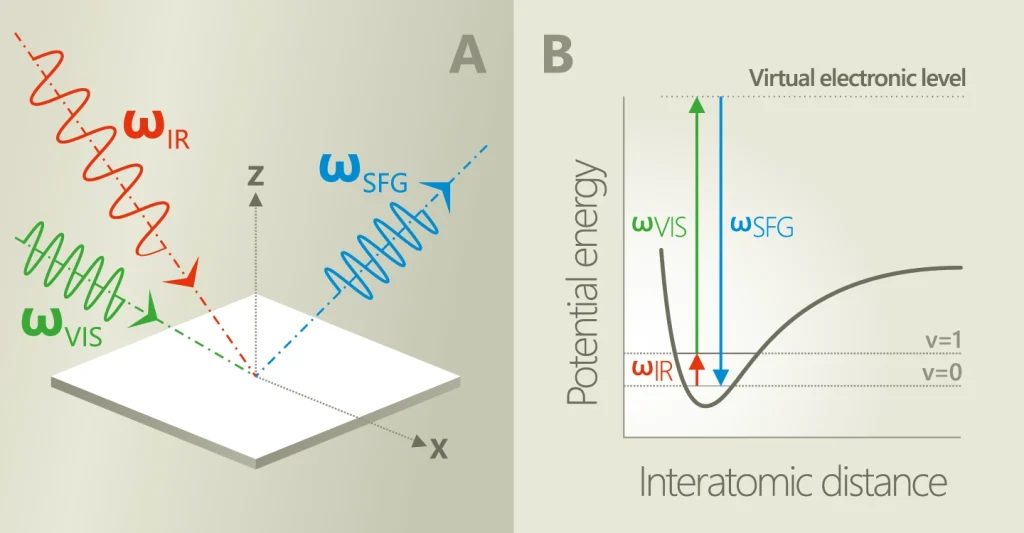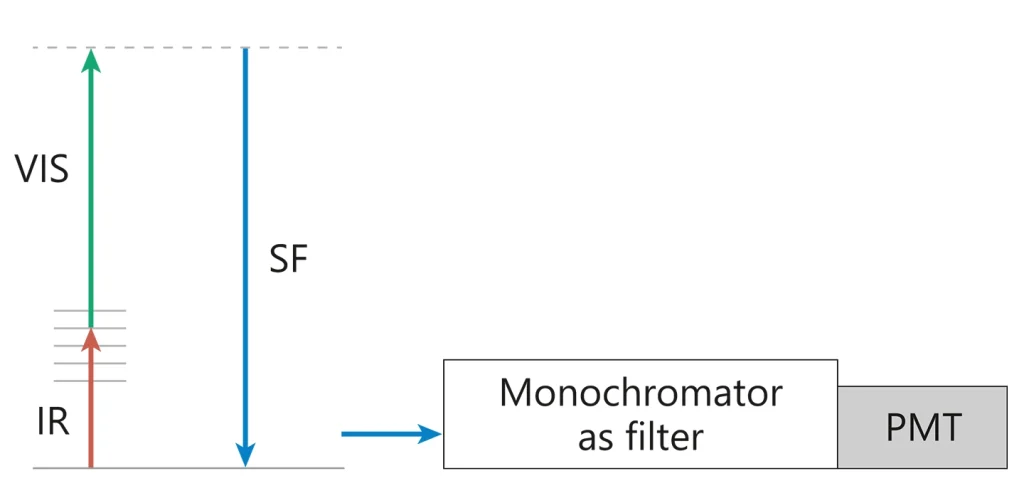Broadband SFG Spectrometer
Broadband Femtosecond Sum Frequency Generation (SFG) Spectrometer
Femtosecond broadband SFG (BB SFG) spectrometer allows fast SFG spectra acquisition since most vibrational modes can be resolved without scanning. The advantage of the broadband SFG system is that intense femtosecond pulses allow efficient sum frequency generation at low pulse energies thus reducing the possibility of sample modification. It is especially important for aqueous and biological samples.
Advantages
- Sensitive and selective to the orientation of molecules in the surface layer
- Intrinsically surface specific
- Selective to adsorbed species
- Sensitive to submonolayer of molecules
- Applicable to all interfaces accessible to light
- Nondestructive
- Capable of high spectral and spatial resolution
Applications
- Investigation of surfaces and interfaces of solids, liquids, polymers, biological membranes and other systems
- Studies of surface structure, chemical composition and molecular orientation
- Remote sensing in hostile environment
- Investigation of surface reactions under real atmosphere, catalysis, surface dynamics
- Studies of epitaxial growth, electrochemistry, material and environmental problems
Sum Frequency Generation Vibrational Spectroscopy
Sum Frequency Generation Vibrational Spectroscopy (SFG-VS) is powerful and versatile method for in-situ investigation of surfaces and interfaces. In SFG-VS experiment a pulsed tunable infrared IR (ωIR) laser beam is mixed with a visible VIS (ωVIS) beam to produce an output at the sum frequency (ωSFG = ωIR + ωVIS). SFG is second order nonlinear process, which is allowed only in media without inversion symmetry. At surfaces or interfaces inversion symmetry is necessarily broken, that makes SFG highly surface specific. As the IR wavelength is scanned, active vibrational modes of molecules at the interface give a resonant contribution to SF signal. The resonant enhancement provides spectral information on surface characteristic vibrational transitions.
Vibrational sum frequency generation (SFG) spectroscopy holds several important advantages over traditional spectroscopy methods for the molecular level analysis of interfaces, including surface sensitivity, vibrational specificity, and the possibility to extract detailed information on the ordering and orientation of molecular groups at the interface by analysis of polarization-dependent SFG spectra.
Spectra examples
Comparison of Narrowband and Broadband SFG Spectrometers
Narrowband picosecond scanning SFG spectrometer
In order to get SFG spectrum during measurement wavelength of narrowband mid-IR pulse is changed point‑by-point throughout the range of interest. Narrowband SFG signal is recorded by the time-gated photomultiplier. Energy of each mid-IR, VIS and SFG pulse is measured. After the measurement, the SFG spectrum can be normalised according to IR and VIS energy. Spectral resolution is determined by the bandwidth of the mid-IR light source. The narrower mid-IR pulse bandwidth, the better the SFG spectral resolution. Separate vibrational modes are excited during the measurement.
Broadband femtosecond SFG spectrometer
A broadband mid-IR pulse is mixed with a narrowband VIS pulse. The result is broadband SFG spectrum which is recorded using a monochromator and a sensitive CCD camera. The full spectrum is acquired simultaneously by integrating signal over time. Spectral resolution is determined by the bandwidth of the VIS pulse and the spectrograph resolution. The narrower the bandwidth of VIS pulse, the better the SFG spectral resolution.
Comparison of different SFG spectrometres
| Narrowband Picosecond Scanning Spectrometer | Broadband Femtosecond High Resolution Spectrometer |
|---|---|
| Narrowband mid-IR excitation, only one band is excited. Coupled states can be separated. | Simultaneous exsitation and recording of broad vibration spectrum with high resolution. |
| High mid-IR pulse energy. Less influence of IR absorbtion in the air. | High mid-IR intensity at low pulse energy – suitable for biological or other water containing samples. |
| No reference spectrum needed, IR energy measured at each spectral point. | Optically coupled IR and VIS channels. Reduced complexity and increased stability of the system. |
Spectra examples
Features and Design
Femtosecond broadband SFG (BB SFG) spectrometer allows fast SFG spectra acquisition since most vibrational modes can be resolved without scanning. The advantage of the broadband SFG system is that intense femtosecond pulses allow efficient sum frequency generation at low pulse energies thus reducing the possibility of sample modification. It is especially important for aqueous and biological samples.
The system is based on a femtosecond industrial grade FemtoLux® series laser with 500 fs pulse duration, more than 1 mJ pulse energy at 1030 nm and a 1 kHz repetition rate. The main part of the laser radiation is directed to a broadband mid-IR OPA module. Broad bandwidth (150 – 450 cm‑1) mid-IR radiation can be continuously tuned in a spectral range from 2.5 up to 10 μm, providing from 0.5 to 12 μJ close to energy transform-limited pulses for the IR channel. The VIS channel implementation depends on the system configuration. In a standard setup, a part of laser output radiation is frequency doubled (515 nm) ~20 µJ and then spectrally filtered to produce <8 cm‑1 bandwidth pulses.
High resolution version consists of optically synchronised femtosecond and picosecond lasers. The combination of broadband mid-IR and narrowband VIS radiation allows to get the broadband sum frequency signal with exceptionally high spectral resolution below <3 cm‑1.
Fast wavelength scan (sweep) allows fast access to wide spectral range. Using time-synchronised motor positions enables fast and smooth wavelength tuning which allows users to scan the full range in just a few seconds or access specific wavelengths within 0.3 seconds.
This allows shifting the central wavelength countinuously during accumulative SFG measurements, effectively broadening the mid-IR bandwidth of a single acquisition and smoothing the mid-IR spectrum for better normalisation. Continuous, gapless tuning from 2.5 to 10 µm with a single polarisation ensures stable beam pointing, enabling seamless spectral measurements across the entire mid-IR range.
Specifications
| Version 1) | SFG FS | SFG FS High Resolution |
|---|---|---|
| System (general) | ||
| Spectral range | 1000 – 4300 cm‑1 | 1000 – 4300 cm‑1 |
| Spectral resolution | < 9 cm‑1 | < 3 cm‑1 |
| Spectral bandwidth 2) | 150 – 450 cm‑1 | 150 – 450 cm‑1 |
| Spectra acquisition method | Broadband accumulative | Broadband accumulative |
| Sample illumination geometry | Top side, reflection | Top side, reflection |
| Incidence beams geometry | Co-propagating, non-colinear | Co-propagating, non-colinear |
| Incidence angles | Fixed, VIS ~60 °, IR ~55 ° (optional: tunable) | Fixed, VIS ~60 °, IR ~55 ° (optional: tunable) |
| VIS beam wavelength | 515 nm | 532 nm |
| Polarization (VIS, IR, SFG) | Linear, selectable “s” or “p”, purity > 1:100 | Linear, selectable “s” or “p”, purity > 1:100 |
| Beam spot on the sample | Adjustable, ~150 – 600 µm | Adjustable, ~150 – 600 µm |
| Sensitivity | Air-water spectra | Air-water spectra |
| Pump laser 3) | ||
| Model | FemtoLux series | FemtoLux series |
| Pulse energy | Optimised to pump broadband OPA | Optimised to pump broadband OPA |
| Pulse duration | 500 ± 50 fs | 500 ± 50 fs |
| Pulse repetition rate | 1000 Hz | 1000 Hz |
| Physical characteristics | ||
| Footprint | 2000 × 1500 mm | 2200 × 1500 mm |
| Version 1) | SFG FS | SFG FS High Resolution |
|---|
- Due to continuous improvement, all specifications are subject to change without advance notice.
- Measured at 30% level.
- Laser is optimised for pumping parametrical generator, maximum output energy may be different than specified for stand alone application.



